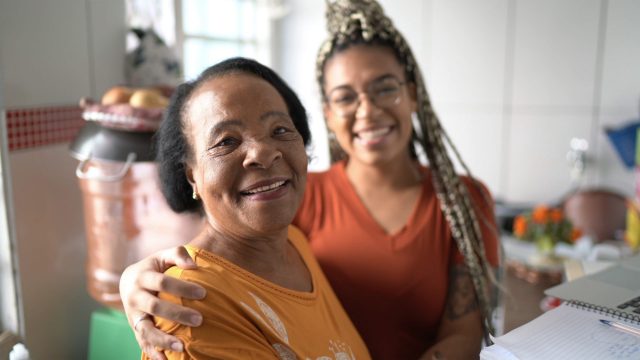What’s Public Health Got To Do With… Healthy Aging?

By Megan Wolfe, Senior Policy Development Manager, Trust for America’s Health
Welcome to the Age-Friendly Public Health Systems (AFPHS) monthly blog series, “What’s Public Health Got to Do With It?” This series is designed to stir up conversation, generate interest, and challenge healthy aging stakeholders to engage more deeply in age-friendly public health issues. Some months, we’ll connect the blog to the AFPHS training session topics (like this month), some months we may ask for your input and feedback on the blog focus, and others, we may simply share thoughts from our team or our partners. TFAH’s AFPHS team looks forward to engaging with you and invites you to join our journey to make healthy aging a core public health function.
What’s Public Health Got To Do With… Family Caregiving? According to the National Alliance for Caregiving, there are 53 million family caregivers in America—that’s one in five of us! Although not all caregivers are providing care for older adults, the number of those that do will grow, as the population of those over 65 is expected to almost double by the year 2060. At that point, one in four of us will have achieved that milestone.
For many family caregivers, myself included, the caregiving journey can be daunting. Information and support – especially when you become a caregiver essentially overnight – can be challenging, confusing, or impossible to find. When I first became a caregiver, lots of well-meaning people offered advice, but no one could point me to a one-stop shop for all the information I would need on insurance coverage, medical supplies, reputable in-home care agencies, transportation, etc., etc. In fact, at this posting, there is no national structure for caregiver support. Of course, since the pandemic began, the value of caregiving and the needs of caregivers have gained visibility, and this is a great start. Support for caregivers should come from a variety of sectors, public health included. Below, I outline some potential roles for public health departments to support caregivers, organized according to TFAH’s AFPHS 5Cs Framework.
- Collecting and disseminating data: Public health uses data to call attention to the needs and assets of a community’s population to inform the development of interventions through community-wide assessment. Collecting data on caregivers and their needs can help to prioritize public health actions and appropriately allocate resources and capacity.
- Coordinating existing supports and services: Searching for and navigating available supports and services for caregivers can be confusing and overwhelming for new and experienced caregivers alike. Public health can create information hubs that organize existing supports and services to make it easier for caregivers to find the information they need. Such coordination could also help to identify duplicate programs as well as gaps.
- Connecting and convening multiple sectors: Public health practitioners excel at convening multi-sector stakeholders to address health and social challenges and many problems find solutions through collective impact approaches. Caregivers could benefit from such collective action resulting from convening the many sectors that provide services and resources for caregivers. Connecting across these sectors could also help to raise awareness of caregivers’ needs and leverage public resources to address those needs.
- Communicating: Through its public communication and networking channels, public health can improve community-wide awareness and access to prevention and health-promoting programs and services. Among the health-promoting programs for caregivers are respite programs. After assessing a community for existing programs, public health departments can accumulate information and translate and disseminate it for caregiver populations, including diverse groups.
- Complementing existing supports: Existing public health programs address a wide range of health issues and are focused on the entire life course. These programs could be assessed to determine if they address the needs of older adults generally, and caregivers specifically. Where programs do not exist, public health departments can build and provide education and training to support caregiver functions.
Bottom line: public health roles are expanding to incorporate the needs of older adults and as they do, caregivers must be included in these systems of care and support.
TFAH’s monthly AFPHS training on July 15 will focus on caregiving as a public health issue. Register today to learn from experts at the National Alliance for Caregiving and Best Practice Caregiving.
August blog: What’s Public Health Got to do With…. Emergency Planning?